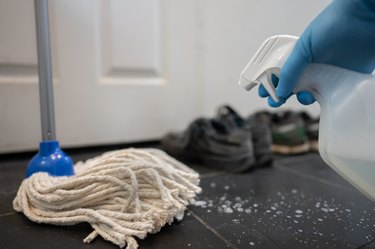
When looking for the best floor cleaning products, not many can beat bleach. Bleach, however, requires specific cleaning methods to reach its full potential. Simple deviances, such as not rinsing, can defeat the purpose of using bleach and can leave bleach residue on floors.
Cleaning Floors With Bleach
Video of the Day
Household bleach is generally too concentrated to use undiluted straight from the bottle on surfaces. Because of this, bleach should be diluted in water before it's applied to the floor. The steps for using bleach to clean floors are: pre-mop the floors to remove dirt and grime, mop the floors with a bleach solution, allow the bleach to sit for at least five minutes and rinse thoroughly with water.
Video of the Day
Try mixing 3/4 cup of bleach for every 1 gallon of water to make a bleach solution for floors. If you are looking to disinfect floors that have come in contact with floodwater, mix 1 cup of bleach for every 5 gallons of water.
Essential Bleach Safety
Bleach is a potent chemical and can cause harm if it is not utilized correctly. Before using bleach, always consult the manufacturer's safety precautions before proceeding.
There are three common safety guidelines to follow when using bleach or any other sanitizing product: Never mix bleach with ammonia or other cleaners; always wear rubber or nonporous boots, gloves and eye protection; and work in a well-ventilated area.
Bleach Residue on the Floor
When some liquids evaporate, they leave behind a layer of residue on the surface. For example, you might have noticed spots on a drinking glass after it dries. This is the result of dissolved minerals present in the liquid that leave behind mineral deposits once the liquid dries.
The same can happen with bleach. Bleach is a water-based solution with sodium hypochlorite (NaClO) as its main active ingredient. Some bleach varieties are higher in sodium hypochlorite than others, with concentrations ranging from 5.25 to 8.25 percent.
When bleach is left to air dry on floors and is not rinsed away, it can leave behind bleach crystals after the bleach evaporates. Sodium hypochlorite will break down into salt and water when left to do so. Since undiluted bleach is mostly water to begin with, once the floor dries, salt crystals will be left behind. The two most common causes for bleach crystals on the floor are the bleach not being rinsed away with water or the bleach solution being too concentrated, making it difficult to rinse away.
Is Bleach Residue Harmful?
When used repeatedly, allowing the residue to build up over time, residues can be potentially harmful to surfaces. Textured surfaces can also collect residue, which can be difficult to remove if it is allowed to build up.
Not all residues are visible and can chemically react with cleaning products. This is a potential risk when cleaning surfaces if you're unaware of the residue left behind.
How to Remove Bleach Residue
Residues left on floors also pose a safety hazard since the buildup can create a slippery surface. Try wiping down the surface with a clean, damp cloth or mop if covering a larger area to remove residue from floors.
If the residue remains, try swiping over the area with the same disinfectant that caused the residue and thoroughly rinse, not allowing the disinfectant to air dry. Then, wipe it clean with a dry cloth. You may need to repeat the process several times depending on the amount of bleach residue on the floor.